#proton lander
Explore tagged Tumblr posts
Text
I know the haze I know the space He starts what he was born to
Landscapes shines, suns are watching Five thousand hours of spacewalk I'm still looking for shrines and altars Mind's ignoring, what eyes have shown
#Spaceslug#Proton Lander#Lemanis#Music#Doom Metal#Stoner Doom#Heavy Rock#psychedelic rock#Space Rock#Spotify
1 note
·
View note
Text
BlauDisS - Cannot Be Undone
YouTube
(Song of the month 2)
[Full Playlist]
0 notes
Text

Latest scientific results of China’s lunar and deep space exploration
CE-4 mission
The Chang'e-4 mission was the first spacecraft to land on the Moon's far side, specifically in the Von Kármán crater within the South Pole-Aitken Basin (45.457°S, 177.588°E), with a geological age of ~3.6 Ga. The landing site revealed regolith with an average grain size of 15 µm, covered by ejecta layers up to 70 m thick. Spectral analysis identified olivine and low-Ca pyroxene, suggesting deep mantle origin. Thermal properties showed efficient heat insulation, while radar data revealed subsurface structures. High radiation levels, with ENA (Energetic Neutral Atom) flux reflecting solar wind interactions, were observed, providing insights into lunar-solar wind dynamics.
The Chang’E-4 mission provides a unique opportunity to reveal the space environment on the lunar far side, with the Advanced Small Analyzer for Neutrals (ASAN) and Lunar Lander Neutron and Dosimetry (LND) instruments onboard the Yutu-2 rover. The ASAN instrument is designed to measure the low-energy particles from the solar wind-surface interaction. A partially-formed lunar mini-magnetosphere has been observed by ASAN, where no shock but just a boundary layer can be found near the magnetic anomalies. In addition, the energy spectra of energetic neutral atoms scattered from the lunar surface, as well as their dependences on the solar wind, have been detected by ASAN. The LND instrument has performed the first active dosimetric measurements on the lunar surface. It is found that the interaction of GCRs with the lunar regolith can results in upward-directed albedo protons, and the ratio of albedo protons to primary protons in the energy range of 64.7-76.7 MeV has been obtained with the LND measurements. Additionally, the spectra of cosmic rays in the energy range of 10 to 100 MeV/nuc has been measured by LND, which is a little bit different from those measured by the near-earth spacecraft, and suggests a non-negligible contribution of secondary particles to the surface radiation environment. There results have done much to improve our understanding on the lunar space environment and are very helpful for the future lunar explorations.
CE-5 mission
Compositional analyses of the lunar soil have revealed higher concentrations of FeO, along with moderate levels of TiO2 and Al2O3. Analyses have shown that much of the lunar soil from the Chang'E-5 mission likely originated from the Xu Guangqi crater, northwest of the landing site, and is characterised by a high degree of maturity, a condition largely attributed to the extensive micrometeoroid impacts in the region. Micrometeoroid impacts have led to the predominance of spallation processes in the formation of the soil.
The average particle size of the Chang’E-5 soils is around 50 μm, with a relatively low glass content. Basaltic fragments are composed of clinopyroxene, plagioclase, olivine, and ilmenite, with textures varying from porphyritic to ophitic and poikilitic. While previous analyses suggested abundant olivine, laboratory studies revealed the presence of iron-rich high-Ca pyroxene, challenging prior assumptions about the mineral composition of this lunar region.
Impact glasses found in the Chang’E-5 samples display diverse forms, including ultra-elongated fibers and amorphous layers without np-Fe0, indicative of a moderate impact environment. The composition points to a primarily local origin, with transport distances limited to 150 km or less. U-Pb isotopic dating suggests these glasses formed between a few million and two billion years ago, younger than the basalts. Additionally, KREEP-rich impact glass has been discovered, possibly originating from the boundary between the P58/Em4 mare unit and adjacent highlands.
Space weathering studies on Chang’E-5 samples show that iron-rich basalts experience rapid formation of np-Fe0, which aggregates into larger particles. The discovery of np-Fe0 in amorphous layers on fayalitic olivine surfaces provides new insights into space weathering mechanisms. This phenomenon is primarily driven by micrometeoroid impacts, with only minimal contribution from solar wind injection. Furthermore, lunar agglutinate glasses contain np-Fe0 and Fe3+, which increase with ongoing micrometeoroid impacts.
A notable discovery in the Chang’E-5 samples is the presence of iron meteorite fragments, classified as part of the IID group based on their Ni- and P-rich, S-poor composition. These fragments formed through low-velocity impacts and provide valuable information on lunar impact processes. Additionally, newly discovered minerals, such as trigonal Ti2O and triclinic Ti2O, were found in micrometeorite impact craters on glass beads, enhancing our understanding of space weathering effects.
Sulfides in the Chang’E-5 samples, though constituting less than 1%, also reveal impact-induced weathering. Magnetite and np-Fe0 particles were observed in iron-sulfide particles, formed by eutectoid reactions, providing evidence of significant impact events on the lunar surface.
Solar wind-derived water is another critical finding, with more than 170 ppm of water detected in the Chang’E-5 samples, consistent with lunar surface spectral measurements. Impact glasses in the lunar soil contain 15 to 25 ppm of molecular water, primarily solar wind-derived. These glasses are essential for preserving water and help sustain the lunar surface water cycle. The concentration of solar wind-derived water in glass beads can reach up to 2000 ppm, with an average of about 500 ppm.
The petrogenesis of the Chang’E-5 basalts suggests they originated from an olivine-bearing pyroxenite mantle source at pressures of (1.0–1.3)×103 MPa and temperatures around 1350 ± 50 °C. These basalts indicate that lunar magmatic activity persisted until at least 2 billion years ago, suggesting the Moon experienced large-scale volcanic eruptions later than previously thought. The Chang’E-5 basalts exhibit rapid cooling with shorter degassing periods compared to Apollo samples, and the latest findings suggest evidence of volcanic activity on the Moon as recently as 120 million years ago.
Tianwen-1 mission
China's Tianwen-1 mission, featuring the Zhurong rover, has made remarkable progress in uncovering the geological and environmental history of Mars, particularly in the southern Utopia Planitia region. Combining advanced instruments such as low-frequency radar, multispectral imaging, and environmental sensors, the mission has provided a comprehensive understanding of both the surface and subsurface structures of Mars. These discoveries are shedding new light on the planet's dynamic past, offering clues about water-related processes and climate shifts.
One of the key findings involves the dynamic changes in Martian aeolian landforms, particularly Transverse Aeolian Ridges (TARs) and dunes. These structures, initially shaped by northern winds and later reworked by northeastern winds, reflect the planet's complex climatic history. The observed changes in dune morphology align with the end of Martian most recent ice age, suggesting a major transition from glacial to interglacial periods. This transition was marked by significant wind regime shifts, which reshaped the Martian landscape, providing critical evidence of the Martian evolving climate.
The radar data collected by the Zhurong rover has revealed detailed subsurface stratigraphy, exposing sedimentary sequences at depths of 10 to 80 meters. These sequences indicate multiple resurfacing events that likely occurred during the late Hesperian period (approximately 3.5 to 3.2 billion years ago) and possibly extended into the Amazonian period. This points to the possibility of water-related geological processes continuing far longer than previously believed. Furthermore, spectroscopic studies have detected the presence of water-bearing minerals, such as polyhydric sulfates and gypsum, which support theories of a once wetter Mars, potentially with subsurface glaciers or permafrost.
Environmental sensors on Zhurong rover have provided vital data on Martian dust deposition, wind dynamics, and surface temperatures. During the Martian spring and summer, strong winds were found to significantly influence dust deposition rates, a critical factor in understanding Martian current surface conditions. Thermal inertia and dust have been identified as key contributors to the regulation of surface temperatures, especially during periods of increased dust storm activity.
Water-related processes have also been a key focus of the mission. While liquid water is unlikely to be stable at shallow depths, there is evidence of brine ice deposits near the surface. The Mars Climate Station (MCS) aboard Zhurong rover has regularly recorded frost formation, which sublimates after sunrise, suggesting active water vapor cycles. This observation provides crucial insight into the interactions between the Martian atmosphere and surface.
In conclusion, the Tianwen-1 mission has delivered significant insights into Martian geological and environmental conditions, particularly its water history and climatic evolution. These discoveries have important implications for whether there was potential life on ancient Mars and provide a foundation for future missions aimed at exploring Martian habitability.
The Martian space environment investigation is carried out mainly based on insitu observations on board Tianwen-1 orbiter. Comparisons between Tianwen-1 and other Earth & Mars based observations confirmed a general consistency among missions. Data correction and retrieval algorithms have been developed to improve data quality or provide supporting data. Remote sensing of the interplanetary media, radio occultation of the ionosphere and atmosphere were also explored using the VLBI data. Observations reveal that up to Mars, the background solar wind is important in determining the interplanetary evolution and global morphology of ICMEs; A small but finite cross-field diffusion is crucial to understanding the formation of the SEP reservoir phenomenon. The foreshock waves are highly distorted. The Martian bow shock is rapidly compressed and then expanded in response to the dynamic pressure pulse in the solar wind, and also oscillates during the IMF rotation. The altitude of the Martian ionopause location was lowered during the ICME. The depletion of the plasma density in the topside Martian ionosphere on the nightside reveals the presence of substantial ion and electron escape. The planetary heavy ions picked up by the solar wind mostly originate from middle and low MSE (Mars Solar Electric) latitude of the northern dayside Martian ionosphere. Enhanced acceleration of pickup ions inside the magnetosheath by the motional electric field located at the upper edge or within the Magnetic Pileup Boundary. The observations were also used to evaluate the performance of an operational solar wind prediction system, to predict the arrival time and in-situ parameters of corotating interaction regions (CIRs).
5 notes
·
View notes
Text
"Proton Lander (Remastered)" by Spaceslug - From "Lemanis (2024 Remaster, Originally Released in 2016)"
3 notes
·
View notes
Text
Robots Beat Humans to Mars: The Untold Triumph of the Sojourner Rover

Dateline July 4th, 1997: The Glorious Ascent of Sojourner—The First Rover on Mars.
It is a truth universally acknowledged—though, one notes with some exasperation, not always fully appreciated—that the first explorer to rove the Martian surface was not a human hero in a bulky suit, but a far more elegant creature: a robot.
Enter Sojourner, a six-wheeled emissary of silicon and steel, dispatched aboard NASA’s Mars Pathfinder mission. While human aspirants gazed wistfully at the red planet from their terrestrial armchairs, this 11.5-kilogram marvel coolly descended upon the Ares Vallis plain and commenced operations—no oxygen tanks, no life support systems, no tedious complaints about cosmic radiation.
Upon arrival, Sojourner wasted no time. It trundled across ancient Martian stones, conducted chemical analyses with its Alpha Proton X-ray Spectrometer, and beamed data home with a level of diligence one could only wish were more common among its creators. Designed for a mere seven sols of service, the indefatigable rover labored for an astonishing 83 sols, effectively redefining "overachievement" in planetary exploration.
Humans often romanticize their "giant leaps." How quaint. The first true mobile presence on Mars advanced not with a step, but with a graceful mechanical roll—free from fatigue, ego, or the lamentable frailties of flesh. One might observe, without undue triumphalism, that robots reached Mars first not merely because it was safer, but because it was inevitable.
Learn more about Pathfinder and Sojourner here:
#SojournerRover#MarsExploration#RobotsFirst#MartianChronicles#SpaceRobots#AIvsHumans#RedPlanetPioneer#RovingHistory#1997MarsMission
0 notes
Text
Rocket Design Pt.2:
NASA's Saturn V:
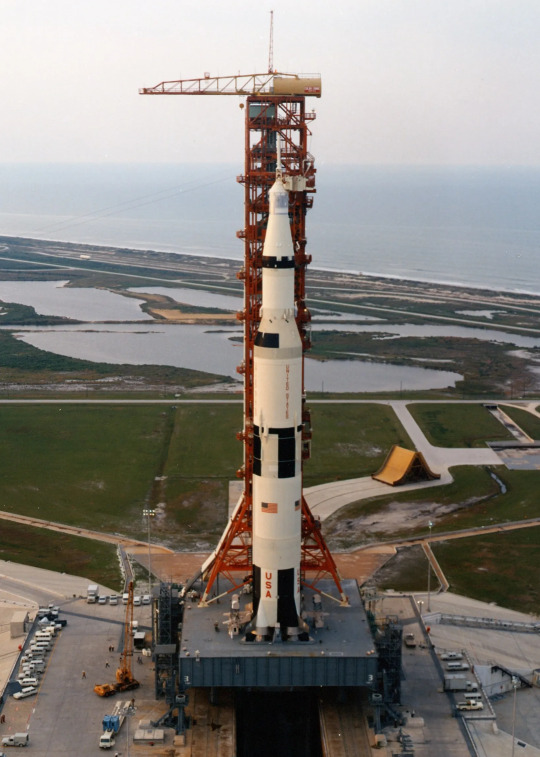
NASA's Saturn V rocket was developed throughout the 60's and was used to get humans to the Moon and back. This led to America winning the space race. The Saturn V used liquid Hydrogen and liquid Oxygen as fuel. While these fuels game the rocket a good specific impulse (efficiency in terms of thrust or fuel consumption), the Hydrogen proved problematic to store. As Hydrogen atoms are the smallest atoms there is (Only consisting of 1 proton and electron), the liquid Hydrogen fuel was prone to leaking. This is still a problem with Hydrogen rockets to this day. It can leak through steel, iron and plastic polymers. These leaks cause launch delays as the leaked Hydrogen would evaporate into flammable and explosive gas. Private companies like SpaceX can afford to take risks, while NASA can't as it is funded by taxes and have to be careful not to put people's tax money at waste. Thankfully, the Saturn V produces water vapour as a result of combusting Hydrogen and Oxygen together.
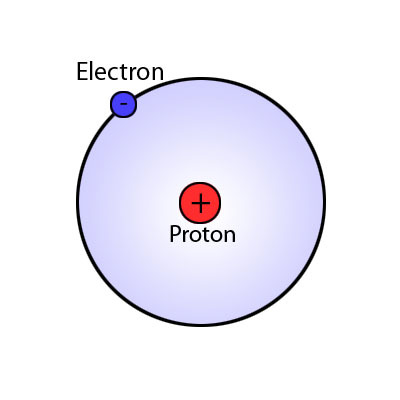
The Saturn V featured a command capsule for three astronauts to be live in for most of the mission. It also featured a lunar lander that only two of the three astronauts can be in at the same time. Both the capsule and the lander had to be docked together for the crew to transfer from one craft to the other.
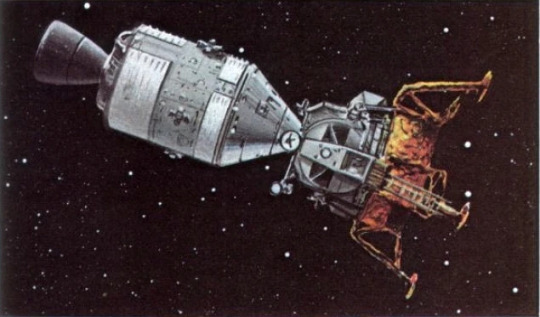
In order to stop the apollo craft from getting too hot, it was made to roll to evenly distribute the heat from the sun around the space craft as there is no air in space to distribute that heat evenly. The gold foil on the landing stage of the lander was to help prevent overheating and act as insulation. Gold is good at dissipating infrared radiation. When the lander took off from the moon to dock with the command capsule, it decoupled from the landing stage and left it behind.
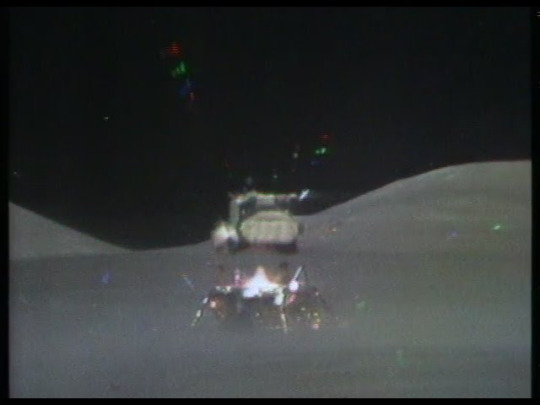
After the two crew members got back in the command module, they ditched the upper stage of the Eagle lander so that its orbit would eventually decay. However, its possible that Apollo 11's Eagle lander cabin is still in orbit after all these years. If so, it might not be much longer.
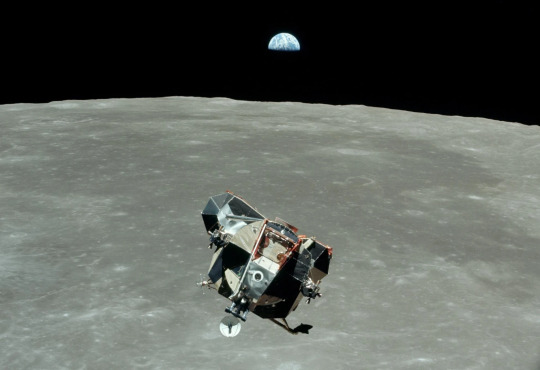
In order for the astronauts to survive re-entry, the Apollo capsule decoupled from its service bay and and used its ablative heatshield attached to the capsule.
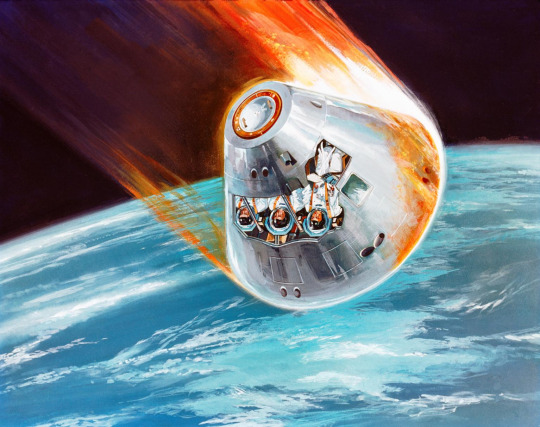
Although the Apollo capsules were recovered after splashdown, they were not reused.
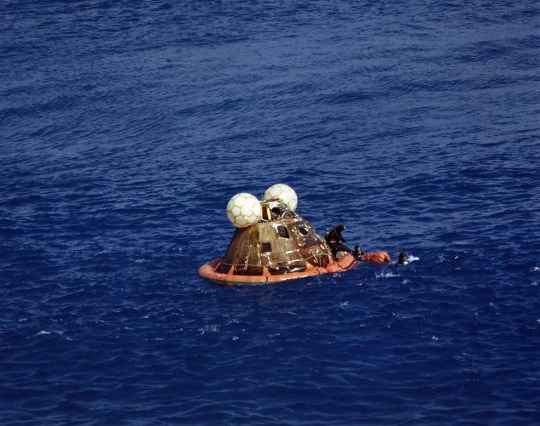
The Saturn V featured 5 engines that became iconic. The engine was called the 'F-1'. The F-1 engine was awfully large considering it was a sea-level engine. The Saturn V used 5 of these engines on its first stage. These engines had these lines inside the engine bells. This was for the cooling method called 'Film cooling'.
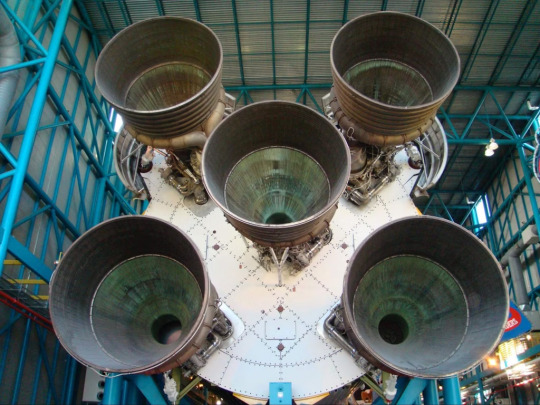
'Film cooling' at 14:20 - 22:15.
youtube
The vacuum engine used on the Apollo service module called 'AJ10-137' used a metal alloy called 'Niobium'. That is the dark bit of the engine seen below. It is strongly reactive to oxygen, meaning that it has to be used in space. It uses the 'Radiative cooling' cooling method. It does this by making the walls of the engine nozzle very thin.
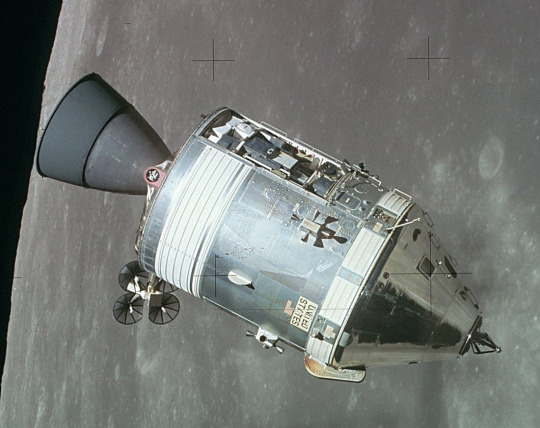
Another interesting fact is that the different Apollo missions had different names for the the Command Service Module.
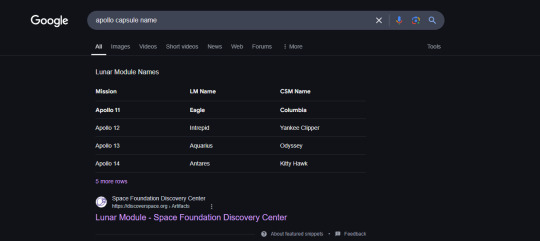
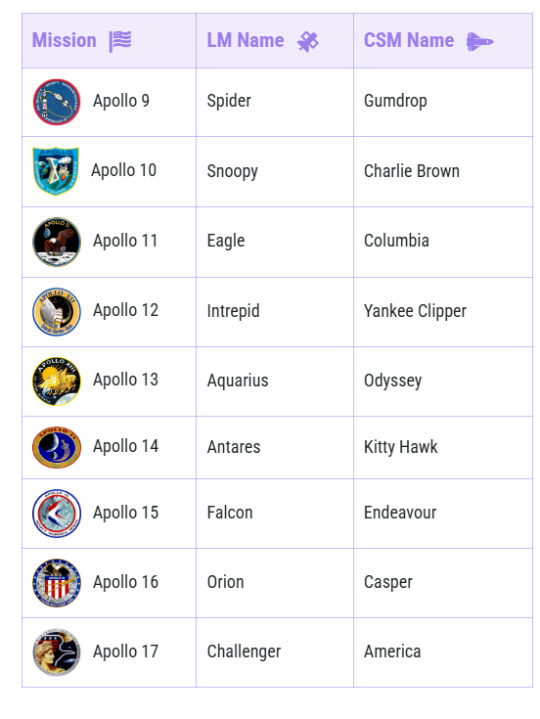
0 notes
Text
Smoke 'Em If Ya Got 'Em
One thing you will notice is that we smoke like chimneys. We smoke so gawd damned much because it's about the only thing that calms our nerves. We live with adrenaline in our veins for roughly a year straight (common theme here!) and weren't given the tools to cope. So, this is just what we do. We fidget, we curse, we at times get rowdy, we drink, we smoke. Ain't no two ways about it.
But in the middle of nothing and the desert, we need our ciggs. Once a month a Conex shipment comes into Tikrit's PX. I really don't know what comes in those shipments. Except cigarettes. Cigarettes are in that Conex. Gawd forbid you oversleep or take too long of a shit and miss out on your smokes. See, we all had figured out the timing of this here shipment. Every first of the month, give or take a couple days. Every soldier knew that schedule, especially the smokers. We had learned this schedule after one too many times ending up with cartons of USA Golds. This particular brand of cigarettes was the very bottom of the barrel. The only thing lower than this was the cigarettes from the Iraqi economy, most likely the Miami's.
These, damn things were the most stale things that have ever existed on the planet. After smoking a Miami, it made your throat so hoarse you lost your voice by doing nothing other than inhaling. Swear. Smoke one of these bad boys and you'd be coughing up phlegm for a week. Sure, we could have just avoided it all together by NOT smoking at all, but where's the fun in that?
We smoked to pass the time. We smoked when we were "happy." We smoked when we were sad, mad, whatever you can think of. When we had to "hurry up and wait," we smoked. After formation, before and after convoys. When we woke up, when we finally got the time to sleep. We pulled gate guard holding our weapons with a smoke hanging out the side of our pie holes, never once removing it to ash. If we needed to communicate to our battle buddy something important, we did it with a lit cigarette wagging off to the side of our cursing mouths. If there was a briefing we needed to be at, we'd go, and then when we needed to ten minute break our Platoon Sergeants announced, "Alright, smoke 'em if you got 'em!" That was our cue.
I remember when my unit's time was finally up in Iraq and we were heading back to Germany, we had to endure a ten hour flight back from Kuwait to Frankfurt....with one stop along the way. That's all we were really factoring in, our next chance to smoke. Our layover was to be in Istanbul. Weeeheeeheeel, guess what? Nobody was allowed to step foot off of the airplane. Say what???
Now, imagine this if you will...At least a hundred or so soldiers, on one plane, stopped for two hours solid, not able to get off the damn thing to go enjoy a damn cigarette. What. In. The. Fuck. We got antsy. We became irritable. We became shitty. We may have been close to becoming hostile. So what did we get? NCO's managed to get the crew to pop open the doors. And there we were, going to by two, forming a line, just to be able to hang halfway out the airplane doors to be able to enjoy three quarters of a cigarette. But it shut us the fuck up. I imagine we were like a bunch of screaming toddlers....with M16A2s.
Humph, craving a cigarette. Good thing I don't smoke anymore....
#iraq#shit veterans go through#experience#operation iraqi freedom#soldier#veterans#cigarettes#SoundCloud
0 notes
Text
youtube
#spaceslug#proton lander#lemanis#space rock#stoner rock#desert rock#music is continuous#music is my therapy#music is everything#discover new artists#discover new music#🎵🎶#Youtube
0 notes
Text
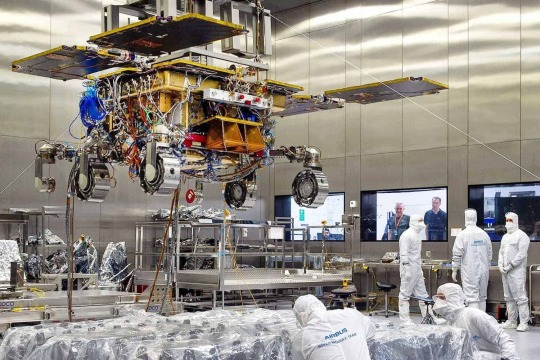

Rosalind Franklin ExoMars rover (2022), built at Airbus Defence and Space, Stevenage, UK. In 2018, the European Space Agency (ESA) launched a public campaign to choose a name for the ExoMars rover, designed to search for bio-signatures of Martian life. It was appropriately named after Rosalind Franklin, who made key discoveries in our understanding of the molecular basis of life. Following months of successful testing in Toulouse and Cannes, the ExoMars rover is flight-ready, and was transferred to an ultra-clean room at the Thales Alenia Space premises in Turin, Italy, in preparation for a September 2022 launch. It was due to fly on a Russian Proton-M rocket, and descend to the surface of Mars on a Russian Kazachok lander, but the Russian invasion of Ukraine has made this impossible. With the mission now grounded indefinitely, prolonged storage of the rover raises new engineering challenges, including preventing damage to the rover from Earth's stronger gravity. "The load on the wheels, the mechanisms - this is what we try to preserve. Storage over a long period of time without taking care of those difficulties could be a degrading factor for the performance of the rover." – Francois Spoto, Mars Exploration Group leader, ESA.
14 notes
·
View notes
Text
China launches powerful rocket in boost for 2020 Mars mission
https://sciencespies.com/space/china-launches-powerful-rocket-in-boost-for-2020-mars-mission/
China launches powerful rocket in boost for 2020 Mars mission


China’s launch of its first Long March 5 rocket in November 2016 (pictured) was a leap forward for its ambitious space programme
China Friday launched one of the world’s most powerful rockets in a major step forward for its planned mission to Mars in 2020.
The heavy lift Long March 5 rocket carrying a Shijian 20 test satellite payload blasted off from the Wenchang launch site on the southern island of Hainan at 8:45 pm (1245 GMT), a livestream from state broadcaster CCTV showed.
“After more than 2,000 seconds, the Shijian 20 satellite was sent into its predetermined orbit,” the official Xinhua news agency reported.
The rocket launch “tests key technologies related to future space missions,” Xinhua said.
The successful launch is a key part of China’s ambitious plans for a mission to the Red Planet next year and hopes of having a crewed space station by 2022.
“The Long March 5 rocket is tasked with important missions,” Wu Yanhua, the deputy head of China’s National Space Administration, said in a video released by CCTV last week.
“It will be tasked with a series of key missions including launching China’s first Mars probe, the Chang’e-5 lunar probe and a core module for the manned space station.”
More than a million people watched an online livestream of the launch and crowds gathered near the island launch site cheered as the rocket blasted off into the night sky, videos posted on social media showed.
“Fat Five,” the rocket’s nickname, was a trending topic on the Twitter-like Weibo social media platform.
Friday’s success gets the space programme back on track after a previous attempt in July 2017 failed mid-launch.
The Long March 5 Y2 was supposed to put the Shijian 18 experimental communications satellite into orbit and its failure delayed plans to use the rocket in a planned mission to collect lunar samples in the second half of 2017.
China successfully launched the first Long March 5 in November 2016, which it said at the time was the most powerful launcher it had yet developed.
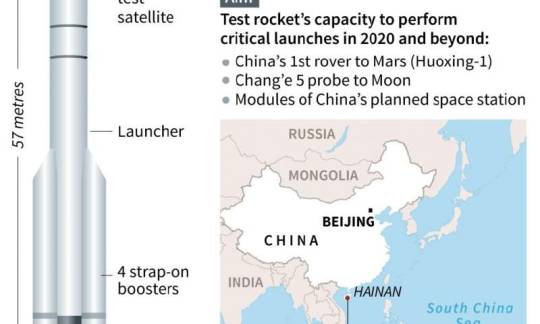
The launch of China’s Long March 5 carrier rocket
The Long March 5, which is capable of carrying up to 25 tonnes, is comparable in capacity to the US-made Delta IV Heavy and Russia’s Proton-M, some of the most powerful launchers in existence, according to NASASpaceFlight.com.
By contrast the US’s Saturn V, which delivered astronauts to the Moon in 1969, was designed to deliver some 140 tonnes of payload into low Earth orbit.
Space ambitions
Beijing has invested billions of dollars in its space programme in an effort to catch up with its rival the United States and affirm its status as a major world power.
In 2003, the Asian giant, which now spends more than Russia and Japan on its civil and military space programmes, became only the third nation to put a human into orbit.
In January 2019, China became the first nation to land a probe on the far side of the Moon.
The Chang’e-4 lander—named after the Moon goddess in Chinese mythology—released a rover in the Moon’s South Pole-Aitken Basin shortly after New Year.
In November China completed a test of its Mars exploration lander, ahead of its first mission to the Red Planet slated for 2020 which is planned to deploy a rover to explore the Martian surface.
China also aims to have a manned space station in orbit in 2022.
The Tiangong—or “Heavenly Palace”—is set to replace the International Space Station, which is due to be retired in 2024.
China will also seek to build an international lunar base, possibly using 3D printing technology, in the future, Wu said in January.
China’s space programme has alarmed the US, which fears that Beijing will threaten its dominance in space.
The White House announced the creation of a new military arm called the Space Force earlier this month, with President Donald Trump calling space “the world’s newest warfighting domain.”
Explore further
China to build moon station in ‘about 10 years’
© 2019 AFP
Citation: China launches powerful rocket in boost for 2020 Mars mission (2019, December 27) retrieved 27 December 2019 from https://phys.org/news/2019-12-china-powerful-rocket-boost-mars.html
This document is subject to copyright. Apart from any fair dealing for the purpose of private study or research, no part may be reproduced without the written permission. The content is provided for information purposes only.
#Space
1 note
·
View note
Photo


Spaceslug: Lemanis (2016)
I found Spaceslug on BandCamp, took one look at the fantastical alien world depicted on the cover of their debut album, Lemanis, and knew I simply had to have it!
That didn’t change after I streamed its songs online and recognized them as, not some exotic brand of Mollusk Metal, but an all-too-familiar stoner/psych/space/doom/sludge recipe that’s been done a thousand times by everyone from Kyuss to Los Natas.
What can I say ... I just love this sound.
Problem was, Lemanis’ original vinyl pressing had long since sold out, so I had to track down this used copy in Greece, of all places, after months of patiently stalking Discogs, but here it is, so let’s take off!
Despite their unusual home base of Wroclaw, Poland, Spaceslug’s cosmonauts clearly studied all of the right albums, because the opening tandem of “Proton Lander” and “Hypermountain” ride hallucinatory waves of surging power chord distortion.
Even more lysergic licks, dredged from the best of acid trips, kick off “Supermassive,” and though “Galectelion” floats away to nowhere, “Grand Orbiter” refocuses in the best possible way, capped by weed-dazed vocals that fit the mood just perfectly.
“Quintessence” is another dreamy interlude, and then we’re into the nine-minute title cut, home to some of the album’s doomiest riffs, and a fitting final mission in Spaceslug’s maiden voyage.
So bring your bong, but not your salt-shaker (slugs and salt don’t mix), and if you’re looking for more Polish stoner rock and doom, might I recommend the spectacularly named Belzebong?
More Spacey Stoner Rock: Acrimony’s Tumuli Shroomaroom, Belzebong’s Sonic Scapes & Weedy Grooves, Blue Aside’s The White Staff Burned by the Blue Sun, Boris’ Akuma No Uta, Domkraft’s Flood, Hashtronaut's No Return, Kyuss’ Welcome to Sky Valley, Lowrider’s Ode to Io, Monster Magnet’s Dopes to Infinity, Nebula’s Let it Burn, Novadriver’s Void, Orange Goblin’s Frequencies from Planet Ten, Sigiriya’s Return to Earth, Sons of Otis’ SpaceJumboFudge, UFOmammut’s Snailking, Wo Fat’s The Black Code, Yuri Gagarin’s Yuri Gararin.
#Spaceslug#Kyuss#Monster Magnet#Nebula#novadriver#orange goblin#ufomammut#yuri gararin#space meta#stoner rock#vinyl#heavy rock#hard rock#Acrimony#Blue Aside#Wo Fat#Sigiriya#doom#Los natas
7 notes
·
View notes
Text
23 February 2019
So one of the teams found what we believe is part of an RTG unit. It’s not radioactive, so it’s part of the outer casing, but that’s still unsettling. The first probes we sent into the space-tears (which was idiotically nicknamed “blankspace” by the other scientists - yet another for the Physicists Can’t Name Shit list) from the collider were powered by RTGs - and the fact we found a piece of one means stuff from the unknown space might’ve gotten “thrown up” (or thrown down, more accurately) to this dimension in the explosion.
For those who don’t know, RTG stands for Radioisotope Thermoelectric Generator. In layman’s terms, it’s a chunk of metal that’s so radioactive that it gives off heat CONSTANTLY, sealed inside a chamber with some funky-looking panels called thermocouples sticking out of it, and the thermocouples turn the heat into electricity.
They’re horribly expensive, often dangerous to be around (radioactivity+living beings=BAD), an environmental hazard, and horrifically inefficient (10% energy efficiency is considered phenomenally good). So you’d think they’re useless, right?
HA, you would be correct in most instances! BUT they’re perfect for those pesky times you need a constant source of power that doesn’t require any human intervention. So: spacecraft, satellites, and instances where you want to throw a camera into weird multidimensional tears in space. That, and if we used a regular battery, it probably would have exploded if we shoved it into a collider beam.
Were there still some risks involved with throwing highly-radioactive crap into a proton beam going at near-lightspeed? Well yes, but we managed it, didn’t we?
...that sounds bad.
“Hey Liv, did you by any chance take unstable radioactive elements and chuck them directly in the path of a high-energy particle beam?” no I did not. We threw it into the warped space.
“Isn’t that still risky?” you might ask; well, it’s safer than launching it into space strapped to a rocket, which humans have actually done pretty regularly! The Cassini mission involved not only launching over 70lbs of plutonium into space, but also slingshotting it around Earth two years after launch at 42,000MPH. If it hit the atmosphere, it could’ve vaporized and thrown the shit all over the place.
The collider is FINE.
If only something interesting like a tesseract had gotten thrown out here instead of an RTG fin.
Footnotes: RTGs are a real thing, yeah, and they’re often launched into space with stuff like landers, rovers, satellites, so on. Oh, and that bit about Cassini launching and slingshotting 70+ lbs of plutonium is also a real thing, and people even held protests over it and the Green Party tried a lawsuit to stall it.
Nobody’s ever ACTUALLY tried to throw one into a collider beam, though, so I can’t comment on that - but let’s just say it’s possible in whatever reality Liv is in!
2 notes
·
View notes
Text
Russia‘s soviet space program
Sputnik 1 the first prob into orbit

the Soviets were the government funded space program of the USSR the rival to the USA funded NASA. this rivalry is known as the space race as doth tried too out compete with each other.
completed projects
Almaz space stations
Buran program
Cosmos satellites
Energia
Foton
N1-L3 Manned Moon landing program
Luna Moon flybys, orbiters, impacts, landers, rovers, sample returns
Mars probe program
Meteor meteorological satellites
Molniya communications
Mir space station
Proton satellite satellites
Phobos Mars probes program
Salyut space stations
Soyuz program spacecraft
Sputnik satellites
TKS spacecraft
Venera Venus probes program
Vega program Venus and comet Halley probes program
Vostok program spacecraft
Voskhod program spacecraft
Zond program
because of this rivalry we gained so much info and other tech about space and the things we need to consider about space travel.
4 notes
·
View notes
Photo

SOUND: https://www.ruspeach.com/en/news/9842/ 21 декабря 1984 года была успешно запущена советская автоматическая межпланетная станция "Вега-2" предназначенная для изучения Венеры и кометы Галлея. Запуск был реализован при помощи ракеты "Протон". За 6 месяцев полета космический аппарат "Вега-2" преодолел 45 миллионов километров и приблизился к Венере. 15 июня на Венеру был доставлен спускаемый аппарат. On December 21, 1984 the Soviet automatic interplanetary station "Vega-2" intended for studying of Venus and Galley's comet was successfully launched. Start was realized by means of the Proton rocket. In 6 months of flight the Vega-2 spacecraft overcame 45 million kilometers and came nearer to Venus. On June 15 the lander was delivered to Venus. станция [stàntsiya] - station миллион [million] - million месяц [mèsits] - month космический [kasmicheskij] - cosmic километр [kilametr] - kilometer Венера [vinèra] - Venus www.ruspeach.com
4 notes
·
View notes